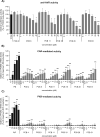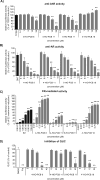In vitro profiling of toxic effects of prominent environmental lower-chlorinated PCB congeners linked with endocrine disruption and tumor promotion
- PMID: 29518658
- PMCID: PMC5908724
- DOI: 10.1016/j.envpol.2018.02.067
In vitro profiling of toxic effects of prominent environmental lower-chlorinated PCB congeners linked with endocrine disruption and tumor promotion
Abstract
The mechanisms contributing to toxic effects of airborne lower-chlorinated PCB congeners (LC-PCBs) remain poorly characterized. We evaluated in vitro toxicities of environmental LC-PCBs found in both indoor and outdoor air (PCB 4, 8, 11, 18, 28 and 31), and selected hydroxylated metabolites of PCB 8, 11 and 18, using reporter gene assays, as well as other functional cellular bioassays. We focused on processes linked with endocrine disruption, tumor promotion and/or regulation of transcription factors controlling metabolism of both endogenous compounds and xenobiotics. The tested LC-PCBs were found to be mostly efficient anti-androgenic (within nanomolar - micromolar range) and estrogenic (at micromolar concentrations) compounds, as well as inhibitors of gap junctional intercellular communication (GJIC) at micromolar concentrations. PCB 8, 28 and 31 were found to partially inhibit the aryl hydrocarbon receptor (AhR)-mediated activity. The tested LC-PCBs were also partial constitutive androstane receptor (CAR) and pregnane X receptor (PXR) agonists, with PCB 4, 8 and 18 being the most active compounds. They were inactive towards other nuclear receptors, such as vitamin D receptor, thyroid receptor α, glucocorticoid receptor or peroxisome proliferator-activated receptor γ. We found that only PCB 8 contributed to generation of oxidative stress, while all tested LC-PCBs induced arachidonic acid release (albeit without further modulations of arachidonic acid metabolism) in human lung epithelial cells. Importantly, estrogenic effects of hydroxylated (OH-PCB) metabolites of LC-PCBs (4-OH-PCB 8, 4-OH-PCB 11 and 4'-OH-PCB 18) were higher than those of the parent PCBs, while their other toxic effects were only slightly altered or suppressed. This suggested that metabolism may alter toxicity profiles of LC-PCBs in a receptor-specific manner. In summary, anti-androgenic and estrogenic activities, acute inhibition of GJIC and suppression of the AhR-mediated activity were found to be the most relevant modes of action of airborne LC-PCBs, although they partially affected also additional cellular targets.
Keywords: Airborne polychlorinated biphenyls; Endocrine disruption; HydroxyLated PCBs; Metabolism of xenobiotics; Tumor promotion.
Copyright © 2018 Elsevier Ltd. All rights reserved.
Conflict of interest statement
The authors declare no conflict of interest.
Figures




Similar articles
-
Toxicity of hydroxylated and quinoid PCB metabolites: inhibition of gap junctional intercellular communication and activation of aryl hydrocarbon and estrogen receptors in hepatic and mammary cells.Chem Res Toxicol. 2004 Mar;17(3):340-7. doi: 10.1021/tx030034v. Chem Res Toxicol. 2004. PMID: 15025504
-
Estrogen-related receptor γ is a novel target for Lower-Chlorinated Polychlorinated Biphenyls and their hydroxylated and sulfated metabolites.Environ Pollut. 2019 Nov;254(Pt B):113088. doi: 10.1016/j.envpol.2019.113088. Epub 2019 Aug 27. Environ Pollut. 2019. PMID: 31491697
-
Binding and activity of sulfated metabolites of lower-chlorinated polychlorinated biphenyls towards thyroid hormone receptor alpha.Ecotoxicol Environ Saf. 2019 Sep 30;180:686-692. doi: 10.1016/j.ecoenv.2019.05.056. Epub 2019 May 27. Ecotoxicol Environ Saf. 2019. PMID: 31146155
-
Complex roles for sulfation in the toxicities of polychlorinated biphenyls.Crit Rev Toxicol. 2024 Feb;54(2):92-122. doi: 10.1080/10408444.2024.2311270. Epub 2024 Feb 16. Crit Rev Toxicol. 2024. PMID: 38363552 Free PMC article. Review.
-
Polychlorinated biphenyls (PCBs): environmental impact, biochemical and toxic responses, and implications for risk assessment.Crit Rev Toxicol. 1994;24(2):87-149. doi: 10.3109/10408449409049308. Crit Rev Toxicol. 1994. PMID: 8037844 Review.
Cited by
-
Cancer Risk following Residential Exposure to Airborne Polychlorinated Biphenyls: A Danish Register-Based Cohort Study.Environ Health Perspect. 2022 Oct;130(10):107003. doi: 10.1289/EHP10605. Epub 2022 Oct 28. Environ Health Perspect. 2022. PMID: 36306207 Free PMC article.
-
3,3'-Dichlorobiphenyl (PCB 11) promotes dendritic arborization in primary rat cortical neurons via a CREB-dependent mechanism.Arch Toxicol. 2018 Nov;92(11):3337-3345. doi: 10.1007/s00204-018-2307-8. Epub 2018 Sep 17. Arch Toxicol. 2018. PMID: 30225637 Free PMC article.
-
Hormone receptor activities of complex mixtures of known and suspect chemicals in personal silicone wristband samplers worn in office buildings.Chemosphere. 2023 Feb;315:137705. doi: 10.1016/j.chemosphere.2022.137705. Epub 2022 Dec 30. Chemosphere. 2023. PMID: 36592838 Free PMC article.
-
Characterization of the Metabolic Pathways of 4-Chlorobiphenyl (PCB3) in HepG2 Cells Using the Metabolite Profiles of Its Hydroxylated Metabolites.Environ Sci Technol. 2021 Jul 6;55(13):9052-9062. doi: 10.1021/acs.est.1c01076. Epub 2021 Jun 14. Environ Sci Technol. 2021. PMID: 34125531 Free PMC article.
-
Identifying sex differences arising from polychlorinated biphenyl exposures in toxicant-associated liver disease.Food Chem Toxicol. 2019 Jul;129:64-76. doi: 10.1016/j.fct.2019.04.007. Epub 2019 Apr 23. Food Chem Toxicol. 2019. PMID: 31026535 Free PMC article.
References
-
- Al-Salman F, Plant N. Non-coplanar polychlorinated biphenyls (PCBs) are direct agonists for the human pregnane-X receptor and constitutive androstane receptor, and activate target gene expression in a tissue-specific manner. Toxicol Appl Pharmacol. 2012;263:7–13. - PubMed
-
- Anezaki K, Kannan N, Nakano T. Polychlorinated biphenyl contamination of paints containing polycyclic- and Naphthol AS-type pigments. Environ Sci Poll Res. 2015;22:14478–88. - PubMed
-
- Anthérieu S, Chesne C, Li R, Camus S, Lahoz A, Picazo L, Turpeinen M, Tolonen A, Uusitalo J, Guguen-Guillouzo C, Guillouzo A. Stable expression, activity, and inducibility of cytochromes P450 in differentiated HepaRG cells. Drug Metab Dispos. 2010;38:516–525. - PubMed
-
- Bartoňková I, Grycová A, Dvořák Z. Profiling of Vitamin D Metabolic Intermediates toward VDR Using Novel Stable Gene Reporter Cell Lines IZ-VDRE and IZ-CYP24. Chem Res Toxicol. 2016;29:1211–1222. - PubMed
MeSH terms
Substances
Grants and funding
LinkOut - more resources
Full Text Sources
Other Literature Sources
Miscellaneous

